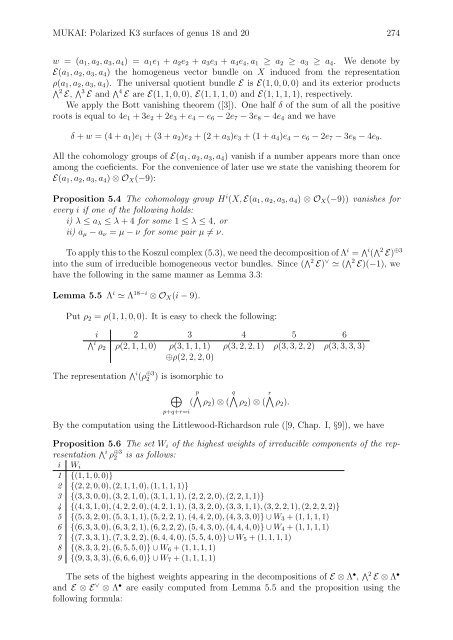Polarized K3 surfaces of genus 18 and 20 - Research Institute for ...
Polarized K3 surfaces of genus 18 and 20 - Research Institute for ...
Polarized K3 surfaces of genus 18 and 20 - Research Institute for ...
Create successful ePaper yourself
Turn your PDF publications into a flip-book with our unique Google optimized e-Paper software.
MUKAI: <strong>Polarized</strong> <strong>K3</strong> <strong>surfaces</strong> <strong>of</strong> <strong>genus</strong> <strong>18</strong> <strong>and</strong> <strong>20</strong> 274<br />
w = (a 1 , a 2 , a 3 , a 4 ) = a 1 e 1 + a 2 e 2 + a 3 e 3 + a 4 e 4 , a 1 ≥ a 2 ≥ a 3 ≥ a 4 . We denote by<br />
E(a 1 , a 2 , a 3 , a 4 ) the homogeneus vector bundle on X induced from the representation<br />
ρ(a 1 , a 2 , a 3 , a 4 ). The universal quotient bundle E is E(1, 0, 0, 0) <strong>and</strong> its exterior products<br />
∧ 2<br />
E, ∧3 E <strong>and</strong> ∧4 E are E(1, 1, 0, 0), E(1, 1, 1, 0) <strong>and</strong> E(1, 1, 1, 1), respectively.<br />
We apply the Bott vanishing theorem ([3]). One half δ <strong>of</strong> the sum <strong>of</strong> all the positive<br />
roots is equal to 4e 1 + 3e 2 + 2e 3 + e 4 − e 6 − 2e 7 − 3e 8 − 4e 4 <strong>and</strong> we have<br />
δ + w = (4 + a 1 )e 1 + (3 + a 2 )e 2 + (2 + a 3 )e 3 + (1 + a 4 )e 4 − e 6 − 2e 7 − 3e 8 − 4e 9 .<br />
All the cohomology groups <strong>of</strong> E(a 1 , a 2 , a 3 , a 4 ) vanish if a number appears more than once<br />
among the coeficients. For the convenience <strong>of</strong> later use we state the vanishing theorem <strong>for</strong><br />
E(a 1 , a 2 , a 3 , a 4 ) ⊗ O X (−9):<br />
Proposition 5.4 The cohomology group H i (X, E(a 1 , a 2 , a 3 , a 4 ) ⊗ O X (−9)) vanishes <strong>for</strong><br />
every i if one <strong>of</strong> the following holds:<br />
i) λ ≤ a λ ≤ λ + 4 <strong>for</strong> some 1 ≤ λ ≤ 4, or<br />
ii) a µ − a ν = µ − ν <strong>for</strong> some pair µ ≠ ν.<br />
To apply this to the Koszul complex (5.3), we need the decomposition <strong>of</strong> Λ i = ∧i ( ∧2 E) ⊕3<br />
into the sum <strong>of</strong> irreducible homogeneous vector bundles. Since ( ∧2 E) ∨ ≃ ( ∧2 E)(−1), we<br />
have the following in the same manner as Lemma 3.3:<br />
Lemma 5.5 Λ i ≃ Λ <strong>18</strong>−i ⊗ O X (i − 9).<br />
Put ρ 2 = ρ(1, 1, 0, 0). It is easy to check the following:<br />
i 2 3 4 5 6<br />
∧ i<br />
ρ 2 ρ(2, 1, 1, 0) ρ(3, 1, 1, 1) ρ(3, 2, 2, 1) ρ(3, 3, 2, 2) ρ(3, 3, 3, 3)<br />
⊕ρ(2, 2, 2, 0)<br />
The representation ∧i (ρ ⊕3<br />
2 ) is isomorphic to<br />
⊕<br />
p+q+r=i<br />
p∧ q∧ r∧<br />
( ρ2 ) ⊗ ( ρ2 ) ⊗ ( ρ2 ).<br />
By the computation using the Littlewood-Richardson rule ([9, Chap. I, §9]), we have<br />
Proposition 5.6 The set W i <strong>of</strong> the highest weights <strong>of</strong> irreducible components <strong>of</strong> the representation<br />
∧i ρ ⊕3<br />
2 is as follows:<br />
i W i<br />
1 {(1, 1, 0, 0)}<br />
2 {(2, 2, 0, 0), (2, 1, 1, 0), (1, 1, 1, 1)}<br />
3 {(3, 3, 0, 0), (3, 2, 1, 0), (3, 1, 1, 1), (2, 2, 2, 0), (2, 2, 1, 1)}<br />
4 {(4, 3, 1, 0), (4, 2, 2, 0), (4, 2, 1, 1), (3, 3, 2, 0), (3, 3, 1, 1), (3, 2, 2, 1), (2, 2, 2, 2)}<br />
5 {(5, 3, 2, 0), (5, 3, 1, 1), (5, 2, 2, 1), (4, 4, 2, 0), (4, 3, 3, 0)} ∪ W 3 + (1, 1, 1, 1)<br />
6 {(6, 3, 3, 0), (6, 3, 2, 1), (6, 2, 2, 2), (5, 4, 3, 0), (4, 4, 4, 0)} ∪ W 4 + (1, 1, 1, 1)<br />
7 {(7, 3, 3, 1), (7, 3, 2, 2), (6, 4, 4, 0), (5, 5, 4, 0)} ∪ W 5 + (1, 1, 1, 1)<br />
8 {(8, 3, 3, 2), (6, 5, 5, 0)} ∪ W 6 + (1, 1, 1, 1)<br />
9 {(9, 3, 3, 3), (6, 6, 6, 0)} ∪ W 7 + (1, 1, 1, 1)<br />
The sets <strong>of</strong> the highest weights appearing in the decompositions <strong>of</strong> E ⊗ Λ • , ∧2 E ⊗ Λ •<br />
<strong>and</strong> E ⊗ E ∨ ⊗ Λ • are easily computed from Lemma 5.5 <strong>and</strong> the proposition using the<br />
following <strong>for</strong>mula:
















